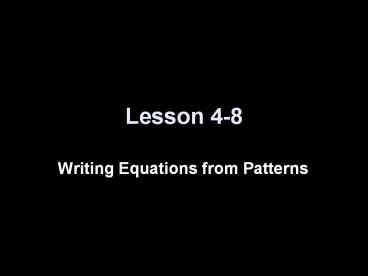Writing Equations from Patterns - PowerPoint PPT Presentation
Title:
Writing Equations from Patterns
Description:
Lesson 4-8 Writing Equations from Patterns Transparency 8 Click the mouse button or press the Space Bar to display the answers. Transparency 8a Objectives Look for a ... – PowerPoint PPT presentation
Number of Views:140
Avg rating:3.0/5.0
Title: Writing Equations from Patterns
1
Lesson 4-8
- Writing Equations from Patterns
2
Transparency 8
Click the mouse button or press the Space Bar to
display the answers.
3
Transparency 8a
4
Objectives
- Look for a pattern
- Write an equation given some of the solutions
5
Vocabulary
- Look for a pattern problem solving technique
- Inductive reasoning deriving a general rule
based on observation of many individual events - Deductive reasoning use a general rule to help
decide about a specific event
6
Example 1
Study the pattern below. Draw the next three
figures in the pattern.
The pattern consists of triangles with one-third
shaded. The section that is shaded is rotated in
a counterclockwise direction. The next three
figures are shown.
Answer
7
Example 1 cont
Study the pattern below. Draw the 17th triangle
in the pattern.
The pattern repeats every third design.
Therefore, designs 3, 6, 9, 12, 15, and so on
will all be the same. Since 15 is the greatest
number less than 17 that is a multiple of 3, the
17th triangle in the pattern will be the same as
the second triangle.
Answer
8
Example 2
Find the next three terms in the sequence3, 1,
3, 9, .... Study the pattern in the sequence.
3 1 3 9
You can use inductive reasoning to find the next
term in the sequence. Notice the pattern 2, 4,
6, .... The difference between each term
increases by two in each successive term. To find
the next three terms in the sequence, continue
adding two to each successive difference. Add 8,
10, and 12.
3 1 3 9 17 27 39
Answer The next three terms are 17, 27, and 39.
9
Example 3
The table shows the number of miles driven for
each hour of driving.
Hours 1 2 3 4
Miles 50 100 150 200
Graph the data. What conclusion can you make
about the relationship between the number of
hours driving, h and the numbers of miles driven,
m?
AnswerThe graph shows a linear relationship
between the number of hours driving and the
number of miles driven.
10
Example 4
Write an equation in function notation for the
relation graphed below.
Make a table of ordered pairs for several points
on the graph.
x 1 2 3 4 5
y 1 4 7 10 13
y is always 2 less than 3x.
11
Summary Homework
- Summary
- Look for a pattern in the data. If the
relationship between the domain and the range is
linear, then the relationship can be described by
an equation - Homework
- none































